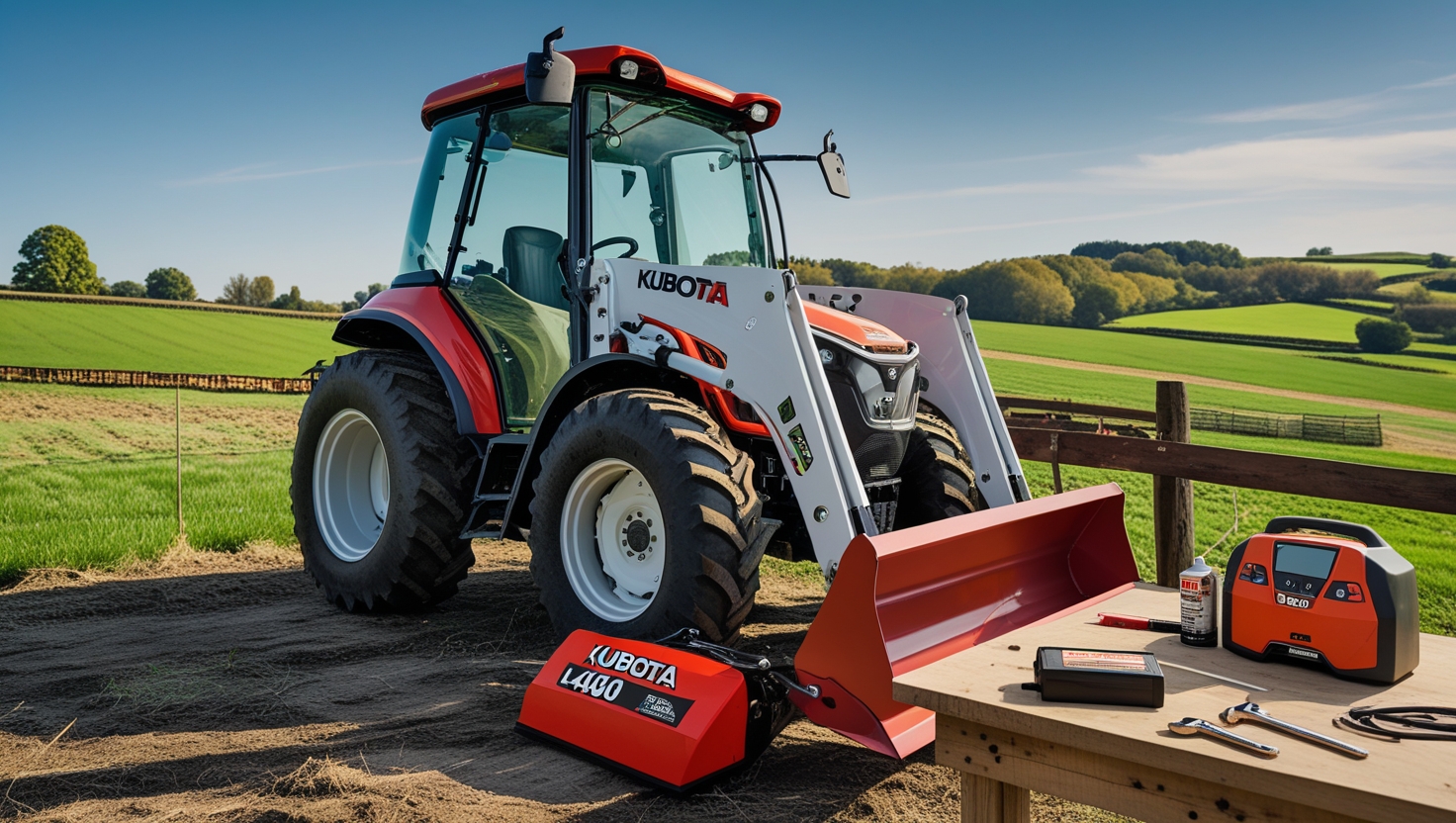Kubota tractors, particularly the L4060 model, are known for their reliability and performance. However, like any piece of machinery, they are not immune to problems. Understanding common issues and knowing how to resolve them can save time and ensure your tractor stays in top condition. While the focus of this article is the Kubota L4060, we’ll also touch on some common Kubota BX2200 problems to provide comprehensive insights.
Whether you’re dealing with hydraulic pump malfunctions, transmission troubles, or starter motor failures, this guide is tailored to help you address these challenges effectively. Let’s delve into the details.
Common Kubota L4060 Tractor Problems
1. Hydraulic Pump Issues
The hydraulic system is essential for operating attachments like the loader and mower deck. Here are common symptoms of hydraulic pump problems:
- Sluggish Operation: Implements like the loader move slower than usual.
- Unusual Noise: Whining or grinding sounds during operation.
- Leaks: Hydraulic fluid pooling under the tractor.
Solutions:
- Check Hydraulic Fluid Levels: Low fluid can cause inefficiencies. Use the recommended hydraulic fluid for your tractor.
- Inspect Hoses and Connections: Tighten loose connections and replace damaged hoses.
- Filter Replacement: A clogged hydraulic filter can restrict fluid flow. Replace it as per the maintenance schedule.
2. Starter Motor and Starter Relay Failures
Starting issues are common with older tractors and are often traced to the starter motor or starter relay. Symptoms include clicking sounds or the engine failing to crank.
Solutions:
- Battery Check: Ensure the battery is fully charged and connections are secure.
- Test the Starter Motor: If the motor doesn’t spin, it may need cleaning or replacement.
- Examine the Starter Relay and Solenoid: Replace faulty components to restore starting functionality.
3. Mower Deck Challenges
The mower deck is crucial for those using their Kubota tractor as a riding mower. Common problems include uneven cuts and deck vibrations.
Solutions:
- Level the Deck: Adjust the mower deck height to ensure even cutting.
- Blade Maintenance: Sharpen or replace dull blades.
- Inspect the Belt: Replace worn or damaged belts to maintain proper tension.
4. Transmission Fluid and Drain Plug Concerns
Transmission issues can manifest as difficulty in shifting gears or jerky movements. Often, these are linked to old transmission fluid or a clogged drain plug.
Solutions:
- Transmission Fluid Change: Use high-quality fluid and adhere to the recommended intervals.
- Clean the Drain Plug: Remove debris or sludge that can block fluid flow.
- Inspect the Gearbox: Look for wear and tear, and replace damaged parts if needed.
5. Loader Performance Problems
A malfunctioning loader can hinder productivity. Common symptoms include the loader not lifting or tilting properly.
Solutions:
- Hydraulic Cylinder Inspection: Replace seals in case of leaks.
- Hydraulic Pump Maintenance: As noted earlier, ensure the pump is working efficiently.
- Control Valve Adjustment: Address misalignments or blockages.
6. Battery Maintenance
A weak or dead battery can immobilize your tractor. Symptoms include dim lights, slow cranking, or no power.
Solutions:
- Clean Terminals: Remove corrosion using a terminal cleaner or baking soda solution.
- Test the Battery: Use a multimeter to ensure the voltage meets specifications.
- Replace as Needed: Install a new battery if it no longer holds a charge.
7. Oil Changes and Oil Filter Maintenance
Regular oil changes are crucial for engine longevity. Neglecting this can lead to overheating or reduced performance.
Solutions:
- Follow the Schedule: Change the oil as recommended in the owner’s manual.
- Use the Right Oil: Stick to the manufacturer’s specifications.
- Replace the Oil Filter: A clean filter ensures the engine runs smoothly.
8. Starter Solenoid Troubles
The starter solenoid is a vital component for initiating the engine. Issues here often lead to starting failures.
Solutions:
- Inspect Wiring: Look for loose or corroded connections.
- Test the Solenoid: Use a multimeter to confirm functionality.
- Replace if Necessary: Install a new solenoid if testing reveals faults.
9. Hydraulic Loader Alignment
If your loader attachment feels misaligned, it may cause uneven operation or stress on the hydraulic system.
Solutions:
- Recalibrate the Loader: Adjust according to the manual’s specifications.
- Inspect Hydraulic Lines: Ensure they’re free of leaks or kinks.
10. Riding Mower Functionality
For those using the Kubota L4060 or BX2200 as a riding mower, mechanical and structural integrity is key.
Solutions:
- Deck Alignment: Keep the mower deck level for consistent performance.
- Replace Worn Bearings: Bearings in the wheels and blades should be in good condition.
- Keep it Clean: Remove grass clippings and debris to avoid clogging.
Preventative Maintenance Tips
Proactive care can prevent many Kubota tractor problems. Here are some best practices:
- Daily Inspections: Before starting work, check for leaks, loose parts, and tire pressure.
- Scheduled Maintenance: Follow the intervals outlined in your owner’s manual for oil changes, filter replacements, and fluid checks.
- Store Properly: Protect your tractor from the elements to reduce wear and tear.
- Clean Regularly: Remove dirt and debris to prevent buildup in key components.
Frequently Asked Questions (FAQs)
1. What are the most common problems with Kubota BX2200 tractors?
Some common problems include hydraulic pump issues, starter motor failures, and transmission fluid leaks. Regular maintenance can help mitigate these issues.
2. How often should I change the oil on my Kubota tractor?
Oil changes should be performed every 50-100 hours of operation, or as recommended in your owner’s manual.
3. Why is my Kubota loader not lifting?
This could be due to low hydraulic fluid levels, a clogged hydraulic filter, or issues with the hydraulic pump. Inspect and address these components.
4. How do I maintain my Kubota mower deck?
Regularly sharpen the blades, clean the deck to remove debris, and ensure the belt is in good condition for optimal performance.
5. What should I do if my Kubota tractor doesn’t start?
Check the battery, starter motor, and solenoid for issues. Ensure all connections are clean and secure.
6. How can I prevent transmission problems in my tractor?
Perform regular transmission fluid changes and keep the drain plug clean to prevent debris buildup.
7. What is the best way to clean a Kubota battery terminal?
Use a terminal cleaner or a mixture of baking soda and water to remove corrosion. Dry and apply a terminal protector after cleaning.
8. When should I replace the hydraulic filter on my tractor?
Hydraulic filters should be replaced every 200-400 hours, depending on usage and the manufacturer’s guidelines.
9. Why is my Kubota mower cutting unevenly?
This could be due to an unlevel mower deck, dull blades, or uneven tire pressure. Address these issues to improve cutting performance.
10. Can I use any oil for my Kubota tractor?
Always use oil that meets the manufacturer’s specifications to ensure engine health and performance.
Conclusion
Addressing issues with your Kubota L4060 or BX2200 doesn’t have to be daunting. With the right knowledge and tools, you can resolve common problems and keep your tractor performing reliably. From hydraulic pump maintenance to ensuring a smooth oil change, regular attention to these areas will extend your tractor’s life and efficiency.
If you’ve faced any unique challenges with your Kubota tractor or have tips to share, we’d love to hear from you. Your feedback helps us and the broader community of Kubota owners. Share your experiences in the comments below or reach out directly!

